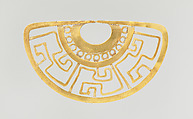Nose ornament
Nose ornaments created by artists of the Salinar culture, which flourished in the coastal river valleys of northern Peru from around 100 BCE—200 CE, are known for their delicate compositions, achieved by cutting and shaping hammered gold sheet and hammering gold wire. Such ornaments would be suspended from the nasal septum.
In the ancient Andes, metals were first and foremost deployed for the creation of adornments for the bodies of the living and the dead. The sheen of polished metals was visible from great distances, catching the light and distinguishing their wearers from other members of society. These ornaments served as status markers and played an important role in establishing identities. Ornaments both concealed and revealed: parts of the face would be obscured, but they would also add another layer of meaning. Identities were transformed, even erased, as the wearer took on a new state of being—perhaps into a divinity in the case of the living, or into a communal ancestor, in the case of the dead.
References and Further Reading
Alva, Walter, and Christopher B. Donnan. 1993. Royal Tombs of Sipán. Los Angeles: Fowler Museum of Cultural History, University of California.
Ikehara, Hugo, and David Chicoine. "Hacia una reevaluación de Salinar desde la perspectiva del valle de Nepeña, costa de Ancash." Andes 8 (2011): 153-184.
Pillsbury, Joanne, Timothy Potts, and Kim N. Richter, Editors. 2017. Golden Kingdoms: Luxury Arts in the Ancient Americas. Los Angeles: The J. Paul Getty Museum and The Getty Research Institute.
This image cannot be enlarged, viewed at full screen, or downloaded.

